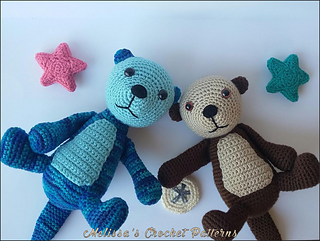patterns >  Melissa's Crochet Patterns' Ravelry Store
Melissa's Crochet Patterns' Ravelry Store
> The Sea Otters











The Sea Otters
Nu ook in het Nederlands verkrijgbaar!
This is the final copy of the pattern, which is an 11 page pdf with many helpful pictures to help you better understand the pattern.
There is an alternate pdf with no pictures, this is 6 pages long.
Your finished sea otter will measure around 9 inches from the top of the head to the bottom of the body, 13 inches including the tail. Your size will vary depending on the yarn you choose, the crochet hook you choose, and your tension while crocheting. I used worsted weight yarn and a size D hook to get my sea otter to this size.
You will need…
- Yarn Color A - 170 yards - Brown/Dark Brown/ or desired main color
- Yarn Color B - 70 yards - Light Brown/Tan or desired secondary color
- Yarn Color C - 10 yards - Color for a Starfish
- Yarn Color D - 10 yards - Color for a Sand dollar
- Small amount of black yarn, or desired color for embroidering the nose.
- 12mm-15mm safety eyes, or desired
- 3.25mm crochet hook (Size D), or desired crochet hook
- Fiberfill Stuffing
- Yarn Needle
- Sewing Pins to hold pieces in place before sewing (optional)
- Stitch Markers
Stitches and Abbreviations used…
- Ch - chain
- Sl - slip stitch
- Sc - single crochet
- Hdc - half double crochet
- Dc - double crochet
- St - stitch
- Sts - stitches
- Rpt - repeat
- Inc - increase, 2 sc in the same space
- Dec - decrease or sc2tog (single crochet 2 together)
Please use your imagination when making your sea otter. Sea otters would look wonderful in any color combination, purple, blue, green, and yellow!
Some facts about sea otters -
-
Like polar bears in the Arctic, sea otters are considered keystone species in their ecosystems, because they affect great influence on their environments. For instance, they plentifully eat sea urchins, which eat kelp in great abundance. When the sea urchins’ populations are controlled by sea otters, vital kelp forests can flourish.
-
To keep from drifting apart while they snooze, sea otters often sleep holding paws.
-
With populations once estimated at close to 300,000, sea otters were hunted extensively for their pelts. Following an international ban on hunting, their numbers rebounded significantly in the 20th century, particularly in Bering Sea and Alaskan waters, their main stomping ground. Still, they remain classified by the International Union for the Conservation of Nature (IUCN) as “endangered.”
-
Sea otters do not migrate far. Their rafts—usually comprised of a single sex—can range from as few as 10 individuals to as high as 1,000.
-
If a sea otter’s fur becomes dirty, it has trouble absorbing the air needed to keep it warm. Therefore, sea otters are obsessive about keeping their fur clean, and groom themselves practically non-stop when they’re not eating or sleeping. Oil spills, therefore, can affect sea otters perhaps more so than any other marine mammal; oil coating their fur can lead to death by hypothermia.
-
The sea otter must consume between 25 and 40 percent of its body weight daily, just to keep warm. They gorge on more than 100 different prey species.
-
Another underwater superlative: The sea otter is the only marine mammal capable of flipping over boulders on the sea floor—in this case to search out food. And the only marine mammal to catch fish with its forepaws and not its mouth.
-
The sea otter is one of the few mammal species on Earth to use a tool to help it hunt and feed. It wedges a rock between its chest and the “armpit” of a foreleg and pounds shells against it to open them up. The sea otter also hammers rocks against strongly gripping abalone shells to pry them off of rocks and feed on their tasty insides.
-
Its fur is the densest of any animal on Earth—an estimated 1 million hairs per square inch. That’s because, unlike its fellow marine mammals, it has no blubber to keep it warm.
-
The sea otter can live its entire life without leaving the water.
Facts found on - http://www.worldwildlife.org/blogs/good-nature-travel/pos...
322326 projects
stashed
110366 times
107061 projects
stashed
30915 times
77609 projects
stashed
41278 times
10555 projects
stashed
5840 times
- First published: January 2017
- Page created: January 8, 2017
- Last updated: February 7, 2023 …
- visits in the last 24 hours
- visitors right now




